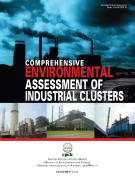 A Comprehensive Environmental Pollution Index (CEPI) is a very useful tool to capture the health dimensions of the environment including air, water and land. The CEPI is intended to act as an early warning tool and can help in categorising the industrial clusters/areas in terms of priority of planning needs for interventions.
A Comprehensive Environmental Pollution Index (CEPI) is a very useful tool to capture the health dimensions of the environment including air, water and land. The CEPI is intended to act as an early warning tool and can help in categorising the industrial clusters/areas in terms of priority of planning needs for interventions.
This report by the Central Pollution and Control Board (CPCB) presents the results of the application of the CEPI to selected industrial clusters or areas.
The main objective of the study was to identify polluted industrial clusters or areas in order to take concerted action and to centrally monitor them at the national level. This was in order to improve the current status of environmental components such as air and water quality data, ecological damage, and visual environmental conditions.
A total of 88 industrial areas or clusters were selected by the CPCB in consultation with the Ministry of Environment & Forests, Government of India for the study. The study found that 43 industrial areas/clusters out of the 88 were critically polluted with respect to one or more environmental components.
The report recommended that severely polluted areas needed to be kept under surveillance and pollution control measures had to be implemented. The critically polluted industrial clusters/areas needed further detailed investigations in terms of the extent of damage and an appropriate remedial action plan had to be formulated.
Thus, a comprehensive analysis of spatial and temporal data needed to be done as a second step for identifying the critical polluted industrial clusters/ areas and to define the spatial boundaries and extent of damage to the eco-geological features. The report also recommended further improvements and alterations towards making CEPI more efficient.
Download the report (also available on the Ministry of Environment and Forests (MoEF) website here):